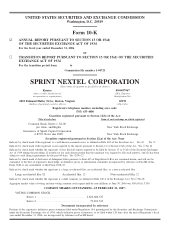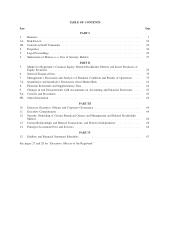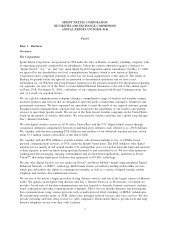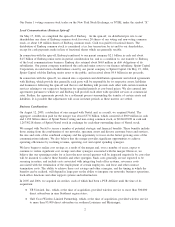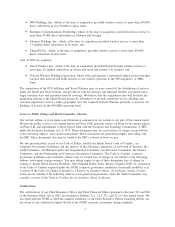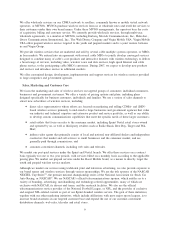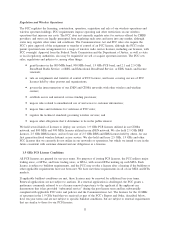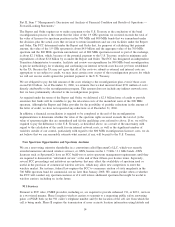Sprint - Nextel 2006 Annual Report Download - page 10
Download and view the complete annual report
Please find page 10 of the 2006 Sprint - Nextel annual report below. You can navigate through the pages in the report by either clicking on the pages listed below, or by using the keyword search tool below to find specific information within the annual report.EV-DO Rev. A is designed to support a variety of IP and video and high performance walkie-talkie
applications for our CDMA network.
The cell site equipment used in the CDMA network often resides on communications towers. In May 2005,
we closed a transaction whereby we provided Global Signal Inc. with the exclusive rights to lease or operate
about 6,500 of our communication towers for a negotiated lease term that is the greater of the remaining terms
of the underlying ground leases or up to 32 years, assuming successful re-negotiation of the underlying ground
leases at the end of their current lease terms. We have committed to sublease space from Global Signal on
about 6,400 of these towers for a minimum of ten years. We have built additional sites to enhance and expand
the coverage of our CDMA network. The acquisition of Nextel has given us access to cell site communications
towers erected for use in connection with the Nextel iDEN network, which in many cases enables us to co-
locate CDMA cell site equipment on these towers, instead of requiring us to erect new towers or co-locate the
equipment on towers owned by third parties, which we expect will reduce our costs. Similarly, we are able to
co-locate iDEN cell site equipment on the CDMA communications towers. We also deploy in-building systems
and outdoor distributed antenna systems where cell site solutions are not feasible.
iDEN Network
We provide our Nextel-branded post-paid and Boost Mobile-branded prepaid wireless services over our iDEN
network. Our iDEN network is an all-digital packet data network based on iDEN wireless technology provided
by Motorola, Inc. We are the only national wireless service provider in the United States that utilizes iDEN
technology, and, generally, the iDEN handsets that we currently offer are not enabled to roam onto wireless
networks that do not utilize iDEN technology. We operate iDEN networks in over 300 metropolitan markets,
including 293 of the top 300 U.S. markets, where about 274 million people live or work.
We have roaming or interoperability agreements with iDEN-based wireless service providers that operate in
selected areas of Canada, Latin America and Mexico, which gives subscribers of iDEN-based services the
ability to utilize our walkie-talkie services to communicate to and from these markets. With an i930 or i920
iDEN handset, subscribers are able to roam in numerous countries outside the U.S., including countries in
Europe. These handsets utilize GSM technology. In addition, any iDEN subscriber can remove the subscriber
identity module card found in each iDEN handset and place it in a Motorola handset that utilizes GSM
technology when traveling outside of the U.S.
Although the iDEN technology offers a number of advantages over other technology platforms, including the
ability to offer our walkie-talkie features, unlike other wireless technologies, it is a proprietary technology that
relies principally on our and Motorola’s efforts for further research, and product development and innovation.
We rely on Motorola to provide us with technology improvements designed to expand our iDEN-based
wireless services, including improvements designed to increase voice capacity and improve our iDEN-based
services. Motorola provides substantially all of the iDEN infrastructure equipment used in our iDEN network,
and substantially all iDEN handset devices. We have agreements with Motorola that set the prices we must
pay to purchase and license this equipment, as well as a structure to develop new features and make long-term
improvements to our network. Motorola also provides integration services in connection with the deployment
of iDEN network elements. We have also agreed to warranty and maintenance programs and specified
indemnity arrangements with Motorola. Motorola is, and is expected to continue to be, our sole source supplier
of iDEN infrastructure and iDEN handsets, except primarily for BlackBerry»devices, which are manufactured
by Research In Motion. Further, our ability to timely and efficiently implement the Report and Order of the
Federal Communications Commission, or FCC, which implemented a spectrum reconfiguration plan designed
to eliminate interference with public safety operators in the 800 MHz band, is dependent, in part, on Motorola.
See “Item 1A. — Risk Factors — If Motorola is unable or unwilling to provide us with equipment and
handsets in support of our Nextel branded services, as well as anticipated handset and infrastructure
improvements for those services, our operations will be adversely affected.”
8

